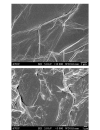[Determination of organophosphorus pesticides based on graphene oxide aerogel solid phase extraction column]
- PMID: 34985211
- PMCID: PMC9404043
- DOI: 10.3724/SP.J.1123.2021.03032
[Determination of organophosphorus pesticides based on graphene oxide aerogel solid phase extraction column]
Abstract
A graphene oxide aerogel was prepared and directly filled in a solid phase extraction (SPE) column without the aid of silica or other substrates. The aerogel was used to extract and detect residual organophosphorus pesticides (phoxim, temephos, fenthion, and fenitrothion) in food, and exhibited good elasticity and high mechanical strength. The graphene oxide aerogel was prepared by freeze-drying. Its morphology and physical properties were characterized by scanning electron microscopy, infrared spectroscopy, and BET surface adsorption. Results proved the successful synthesis of the graphene oxide aerogel. Scanning electron micrographs of the aerogel exhibited a layered and fold structure, with a surface area of 740.51 m2/g. The effect of experimental conditions on the extraction recovery of organophosphorus pesticides was systematically studied through a series of single-factor experiments. Due to limited adsorption sites, sample volumes of 5-60 mL were investigated, and 15 mL was determined was the optimum sample volume. The rate of sample loading was investigated in the range of 0.8-3.0 mL/min. When the rate of sample loading was higher than 3.0 mL/min, the insufficient contact between the analytes and sorbent appeared to cause a decrease in the extraction recovery. A lower rate of sample loading would prolong the operation time due to the re-elution of organophosphorus pesticides. The sample pH was optimized from a pH range of 2-11. An acidic solution was found to be good for inducing electrostatic interactions between the graphene oxide aerogel and organophosphorus pesticides. The maximum extraction recoveries were obtained at pH 4. Three eluents (acetonitrile, methanol, and acetone) were explored for optimization, and results showed that acetonitrile was the most appropriate eluent. The eluent volume (0.6-1.2 mL) was also investigated, and the optimal value was found to be 1.0 mL. Compared with commercial extraction materials including C18 silica, the anion exchange column (SAX), amino (-NH2), and Florisil, the extraction recovery of this new material showed distinct improvement. The lifetime of the extraction column directly filled with the graphene oxide aerogel was investigated. The column could be repeatedly used for 15 times, which overcame the issue of blocking of the sieve plates of fragmented graphene nanosheets dispersed without any matrix support. The linearities of the four organophosphorus pesticides were 1-200 μg/L for phoxim, temephos, and fenthion, and 2-200 μg/L for fenitrothion. The linear correlation coefficients were all ≥0.9949, and limits of detection were in the range of 0.2-0.5 μg/L. An extraction column was used to extract the analytes continuously for five times, and the RSDs of the extraction recoveries were ≤6.5%. Subsequently, five extraction columns were used to extract the analytes under the same conditions, and the RSDs of the extraction recoveries were ≤11.3%. Finally, the established method was applied for the extraction and detection of a real sample (apple peel); no organophosphorus pesticide was detected in the apple peel. The recoveries for spiked standard solutions were between 70.5% and 93.6%, and RSDs were ≤10.4%.
以氧化石墨烯气凝胶三维纳米材料作为固相萃取的吸附剂,结合高效液相色谱,对食品中的有机磷农药(辛硫磷、双硫磷、倍硫磷、杀螟硫磷)进行检测分析。首先,利用冷冻干燥的方式制备得到氧化石墨烯气凝胶,通过扫描电镜、红外光谱、比表面积吸附等一系列的实验手段对其形貌及物理特性进行了表征,证明其成功合成。从扫描电镜中可见石墨烯的层状褶皱结构,其表面积为740.51 m2/g。然后,将氧化石墨烯气凝胶直接填充于固相萃取柱中,在未借助任何硅胶等基体的条件下进行萃取研究;通过单因素实验,系统研究了萃取和洗脱条件对有机磷农药萃取回收率的影响。结果显示,在上样体积15 mL、样品溶液pH值4、上样速率1.0 mL/min、洗脱剂1.0 mL乙腈的条件下萃取回收率最高。与商用的萃取材料进行比较,包括碳十八硅胶柱(C18)、阴离子交换柱(SAX)、氨基柱(-NH2)和硅酸镁柱(Florisil),氧化石墨烯气凝胶填充的固相萃取柱的萃取回收率有明显提高。实验考察了氧化石墨烯气凝胶直接填充的萃取柱的寿命,结果显示该萃取柱可以重复使用15次,可见解决了分散无基体支撑的石墨烯纳米片容易破碎、堵塞筛板的问题。与液相色谱联用建立分析方法,4种有机磷农药的线性范围较宽,辛硫磷、双硫磷和倍硫磷的线性范围为1~200 μg/L,杀螟硫磷的线性范围为2~200 μg/L,线性拟合良好(线性相关系数r2≥0.9949),检出限为0.2~0.5 μg/L,满足于我国和其他国家限定标准的检测。将该方法应用于实际样品,在苹果皮中未检测到有机磷农药,对其进行加标,回收率为70.5%~93.6%,相对标准偏差≤10.4%。
Keywords: graphene oxide aerogel; high performance liquid chromatography (HPLC); organophosphorus pesticides; solid phase extraction (SPE).
Figures
Similar articles
-
[Preparation and application of graphene oxide functionalized melamine-formaldehyde aerogel coated solid-phase microextraction tube].Se Pu. 2022 Oct;40(10):889-899. doi: 10.3724/SP.J.1123.2021.12032. Se Pu. 2022. PMID: 36222252 Free PMC article. Chinese.
-
[Utilization of UiO-66-NH2@cellulose hybrid aerogel for solid-phase extraction of sildenafil in health products].Se Pu. 2022 Jun;40(6):556-564. doi: 10.3724/SP.J.1123.2021.11022. Se Pu. 2022. PMID: 35616201 Free PMC article. Chinese.
-
ZrO2 Nanoparticles and Poly(diallyldimethylammonium chloride)-Doped Graphene Oxide Aerogel-Coated Stainless-Steel Mesh for the Effective Adsorption of Organophosphorus Pesticides.Foods. 2021 Jul 13;10(7):1616. doi: 10.3390/foods10071616. Foods. 2021. PMID: 34359486 Free PMC article.
-
The Current Role of Graphene-Based Nanomaterials in the Sample Preparation Arena.Front Chem. 2020 Aug 11;8:664. doi: 10.3389/fchem.2020.00664. eCollection 2020. Front Chem. 2020. PMID: 32850673 Free PMC article. Review.
-
An Updated Review on Functionalized Graphene as Sensitive Materials in Sensing of Pesticides.Chem Biodivers. 2024 Jun;21(6):e202302080. doi: 10.1002/cbdv.202302080. Epub 2024 May 6. Chem Biodivers. 2024. PMID: 38578653 Review.
Cited by
-
[Modified QuEChERS method based on multi-walled carbon nanotubes coupled with gas chromatography-tandem mass spectrometry for the detection of 10 pyrethroid pesticide residues in tea].Se Pu. 2022 May 8;40(5):469-476. doi: 10.3724/SP.J.1123.2021.11015. Se Pu. 2022. PMID: 35478006 Free PMC article. Chinese.
References
MeSH terms
Substances
LinkOut - more resources
Full Text Sources
Medical





